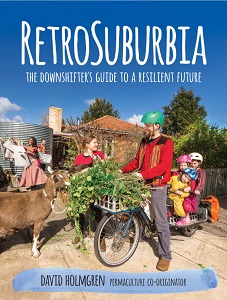
David Holmgren co-created the philosophy of Permaculture while living in Australia in the 1970s. More than just a gardening method, “permaculture could be better described as a design system for resilient living and land use based on universal ethics and ecological design principles.” Holmgren writes
RetroSuburbia : the downshifter's guide to a resilient future from the point of view that the future will become increasingly difficult because of “energy descent” (scarcity) and general global economic depression. However, his tone is optimistic and pragmatic ꟷ he has led a self-reliant life and so can you.
Retrosuburbia is a thick manual with a philosophical foundation for those wishing to be environmentally conscientious, resilient and self-reliant. Holmgren distills the rationale of his guide as: “… downshifting away from consumption supported by paid work and debt to a culture of voluntary simplicity and permaculture productivity.”
The book is divided into three fields: built, biological, and behavioral. Each discussion point draws from 12 permaculture design principles. such as “integrate rather than segregate” and “use and value diversity.” These principles have a corresponding icon that is included every time the principle is invoked. ...
The book will be instructive for people concerned about the climate crisis, those wanting to be self-sufficient and even those on a path to FIRE (Financial Independence, Retire Early). There are no suggestions to head for the hills and retreat from society, but instead Holmgren instructs readers how to retrofit urban and suburban developments to support growing food and meeting life’s necessities while transitioning away from conventional modes of employment and consumption.
Editor's note: this is an excerpt from Tracy's complete review, published in the Gardening Answers Knowledgebase at www.millerlibrary.org.